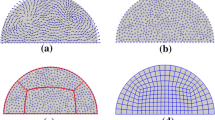Abstract
In this paper, we present a new method for adaptive all-quadrilateral mesh generation for two-dimensional domains, including domains modeled by constraints with complex geometry or with varying scales. The method subdivides the domain’s bounding box using a new extended quadtree scheme. In this subdivision process, the quadtree node corners are moved onto the geometrical constraints using local deformation criteria during the tree refinement steps. We define new subdivision patterns as part of our extended quadtree to add flexibility in the adaptation and guarantee that geometrical constraints are entirely modeled by tree edges. During the process, we ensure grid alignment with constraint accuracy and element quality at every scale. Our proposal converts the tree structure into a mesh with only quadrilateral elements. Results showed that our method generates elements of reasonable quality even for complex geometries and varying scales. The small number of parameters controlling the process is intuitive and makes our method efficient and user friendly.



















Similar content being viewed by others
References
Zienkiewicz OC, Taylor RL, Zhu JZ (2005) The finite element method: its basis and fundamentals. Elsevier Butterworth-Heinemann, Oxford
Catmull E, Clark J (1978) Recursively generated B-spline surfaces on arbitrary topological meshes. Comput Aided Des 10:350–355
Liu Y, Xing HL, Guan Z (2011) An indirect approach for automatic generation of quadrilateral meshes with arbitrary line constraints. Int J Numer Methods Eng 87:906–922
Borouchaki H, Frey PJ (1998) Adaptive triangular-quadrilateral mesh generation. Int J Numer Methods Eng 41:915–934
Owen SJ, Staten ML, Canann SA, Saigal S (1999) Q-Morph: an indirect approach to advancing front quad meshing. Int J Numer Methods Eng 44:1317–1340
Lee K-Y, Kim I-I, Cho D-Y, Kim T-W (2003) An algorithm for automatic 2D quadrilateral mesh generation with line constraints. Comput Aided Des 35:1055–1068
Ebeida MS, Karamete K, Mestreau E, Dey S (2010) Q-TRAN: A new approach to transform triangular meshes into quadrilateral meshes locally. Proceedings of the 19th International Meshing Roundtable 23–34
Araújo C, Celes W (2014) quadrilateral mesh generation with deferred constraint insertion. Procedia Eng 82:88–100
Blacker TD, Stephenson MB (1991) Paving: a new approach to automated quadrilateral mesh generation. Int J Numer Methods Eng 32:811–847
Cass RJ, Benzley SE, Meyers RJ, Blacker TD (1996) Generalized 3-D paving: an automated quadrilateral surface mesh generation algorithm. Int J Numer Methods Eng 39:1475–1489
Talbert JA, Parkinson AR (1990) Development of an automatic, two-dimensional finite element mesh generator using quadrilateral elements and Bezier curve boundary definition. Int J Numer Methods Eng 29:1551–1567
Chae SW, Jeong JH (1997) Unstructured Surface Meshing Using Operators. In: Proc. of the 6th International Meshing Roundtable. Park City, Utah, pp 281–291
Nowottny D (1997) Quadrilateral mesh generation via geometrically optimized domain decomposition. In: Proceedings, 6th International Meshing Roundtable, pp 309–320
Tam T, Armstrong C (1991) 2D finite element mesh generation by medial axis subdivision. Adv Eng Softw Workst 13:313–324
Miranda ACDO, Martha LF (2013) quadrilateral mesh generation using hierarchical templates. Proceedings of the 21st International Meshing Roundtable, pp 279–296
Frey PJ, Marechal L (1998) Fast adaptive Quadtree Mesh Generation. In: Proc. of the 7th International Meshing Roundtable, pp 211–224
Ebeida MS, Davis RL, Freund RW (2010) A new fast hybrid adaptive grid generation technique for arbitrary two-dimensional domains. International Journal for Numerical Methods in Engineering Int J Numer Methods Eng
Yerry M, Shephard M (1983) A modified quadtree approach to finite element mesh generation. IEEE Comput Grap Appl 3:39–46
Rushdi AA, Mitchell SA, Bajaj CL, Ebeida MS (2015) Robust all-quad meshing of domains with connected regions. Procedia Eng 124:96–108
Schneiders R, Bünten R (1995) Automatic generation of hexahedral finite element meshes. Comput Aided Geom Des 12:693–707
Liang X, Ebeida MS, Zhang Y (2009) Guaranteed-quality all-quadrilateral mesh generation with feature preservation. Proceedings of the 18th International Meshing Roundtable 45–63
Schneiders R, Schindler R, Weiler F (1996) Octree-based generation of hexahedral element meshes. Fifth International Meshing Roundtable, pp 205–216
Atalay FB, Ramaswami S, Xu D (2008) Quadrilateral meshes with bounded minimum angle. Proceedings of the 17th International Meshing Roundtable, pp 73–91
Samet H (1982) Neighbor finding techniques for images represented by quadtrees. Comput Graph Image Process 18:37–57
Martti Mäntylä (1988) An introduction to solid modeling. Computer Science Press, Rockville
Herrmann LR (1976) Laplacian-isoparametric grid generation scheme. J Eng Mech Div ASCE 102:749–756
Ebeida MS, Patney A, Owens JD, Mestreau E (2011) Isotropic conforming refinement of quadrilateral and hexahedral meshes using two-refinement templates. Int J Numer Methods Eng 88:974–985
Lage M, Martha LF, Almeida JPMD, Lopes H (2015) IBHM: index-based data structures for 2D and 3D hybrid meshes. Eng Comput 1–18
El-Hamalawi A (2000) A simple and effective element distortion factor. Comput Struct 75:507–513
Kinney P (1997) CleanUp: Improving Quadrilateral Finite Element Meshes. Proceedings of the 6th International Meshing Roundtable, pp 437–447
Lorensen WE, Cline HE (1987) Marching cubes: a high resolution 3D surface construction algorithm. ACM SIGGRAPH Comput Graph 21:163–169
Mitchell SA (1999) The all-hex geode-template for conforming a diced tetrahedral mesh to any diced hexahedral mesh. Eng Comput 15:228–235
Yamakawa S, Shimada K (2002) HEXHOOP: modular templates for converting a hex-dominant mesh to an ALL-hex mesh. Eng Comput 18:211–228
Acknowledgments
We would like to thank the reviewers for their valuable suggestions and insightful critiques that certainly improve the overall legibility and quality of this manuscript. The authors would like also to thank CNPq for partially supporting this reseach.
Author information
Authors and Affiliations
Corresponding author
Rights and permissions
About this article
Cite this article
Pochet, A., Celes, W., Lopes, H. et al. A new quadtree-based approach for automatic quadrilateral mesh generation. Engineering with Computers 33, 275–292 (2017). https://doi.org/10.1007/s00366-016-0471-0
Received:
Accepted:
Published:
Issue Date:
DOI: https://doi.org/10.1007/s00366-016-0471-0




